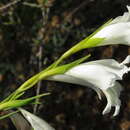Biology
provided by Arkive
Like many species in the Cape Floristic Region, the blue pipe is a geophyte (4), meaning that it is capable of surviving long periods of unfavourable conditions by using an underground food storage organ (5). During the dry season, the above ground parts of the blue pipe die back, but the plant persists in the soil as a short, swollen stem known as a corm. In winter, the onset of the rains triggers the dormant corm to renew its above-ground growth (4) (5), with flowering occurring from June to August (2).
Conservation
provided by Arkive
Like other plant communities within the Cape Floristic Region, such as fynbos, only a small proportion of renosterveld is protected (6). Through researching its ecology, the Cape Action for People and the Environment partnership is working to determine how best to manage renosterveld and conserve its biodiversity. These management strategies can then be employed by willing landowners, thereby ensuring that beautiful species such as the blue pipe are preserved (7).
Description
provided by Arkive
A member of the iris family, the blue pipe is one of the many species of Gladiolus that grow in the incredibly biodiverse Cape Floristic Region (2) (4). The Latin name gracilis, meaning slender, accurately describes this species' appearance, with the leaves rolled into slim, hollow tubes which branch from a long, thin central stem. The blue pipe's most striking feature is its large, fragrant flowers. Reaching 2.5 centimetres in width, they are mainly blue or grey with dark streaks, although occasionally pink or yellow varieties occur (2).
Habitat
provided by Arkive
The blue pipe generally occurs in renosterveld, a plant community unique to the Cape Floristic Region, which grows in regions with grey, clay-rich shale and granite soils, where annual rainfall is between 250 and 600 millimetres (2) (4).
Range
provided by Arkive
The blue pipe is found only in the western and south-western regions of the Western Cape Province of South Africa (2).
Status
provided by Arkive
Classified as Near Threatened (NT) on the Interim Red Data List of South African Plant Taxa (3).
Threats
provided by Arkive
Since the arrival of the first European settlers, the highly-fertile soils which support renosterveld vegetation have been targeted for crop-growing (2). Today, the ongoing conversion to agriculture has consumed over 70 percent of renosterveld vegetation (4), leaving the remaining areas fragmented and subject to grazing, trampling, crop spraying and frequent burning (6). While there is no current information about the population status of the blue pipe, the ongoing degradation and loss of its principal habitat (4) are likely to be threatening its survival.

